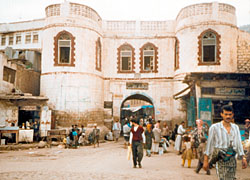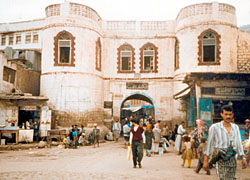
History Ruined, While We Watch [Archives:2001/06/Last Page]
February 5 2001

There are more than 32 ancient schools in the old city of Taiz some of which are still a silent witness to the different eras the city has gone through.
According to historical sources, the city was built by Shams Addawlah Nuran Shah, brother of Salahaddin Al-Ayobi in 1173. The construction was then completed by Taghtakeen, Nurans brother. Al-Moez, son of the latter established the first schools in the city.
The city was expanded further during the rule of the Rasolians in 1229. At this time Taiz was the capital of the Rasolians headed by Yosef Rasoul Al-Modhaffar.
Attractive Gateways
To ensure the safety of the city at night, many gates were built such as Al-Bab Al-Kabeer and Bab Al-Madajer. Bab Mossa was one of the main entrances of the city and these were shut at night. The historic wall was built during the reign of Al-Mutahar ben Al-Imam Sharafaddin in 1535. It was built by the ruler of Sadah, Al-Faqih Yahia Ibrahim Al-Nuseiry. It took him 7 years and three months to build the whole wall of bricks, stones, etc.
Bab Mossa
This gate with its vault has survived centuries and still preserves its old shape and style. When the wall was built, Bab Mossa was narrow. It was then widened by the Ottoman ruler Mahmoud Basha in about 1548 to enable movement of people. Today, people, cars, carriages, etc. can pass through the gate.
The Gate leads to different directions such as Al-Musalla and Al-Makha road to the north and west of Taiz city.
Engravings
On the two sides of the gate are engraved some verses from the Holy Quran, to which the name of the gate, and recently the name of a police station have been added. On the gate there are a number of look-outs which were built to control opening and closing hours. These are similar to those on Bab Al-Yemen which have been converted into a tourist information center while Bab Mossa is today a police station.
The largest parts of the wall have been ruined and the remaining parts are in dire need of renovation. As for Bab Mossa, it is sad to say that the general authority to preserve historic cities has not tried to preserve the style of this ancient gate.
Generally speaking, the ancient sites, schools and gates of Taiz need more attention so that they do not suffer the same fate as the wall. Qubat Al-Husseiniah, for example, is surrounded by garbage and trees have grown on its wall. Nearby is Qubat Abdulhadi, Al-Ashrafiah school, remains of King Al-Mwaids rest house and a small cupola which is believed to be the grave of Al-Shabzi. All cry for more attention.
Such sites and places must be preserved and protected, especially Bab Mossa which can be converted into a small museum for pictures of and information on Taiz.
——
[archive-e:06-v:2001-y:2001-d:2001-02-05-p:./2001/iss06/lastpage.htm]


